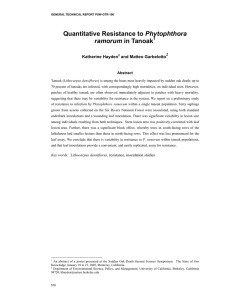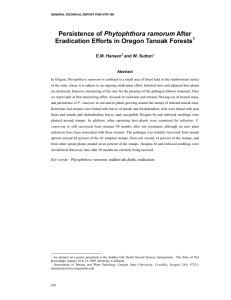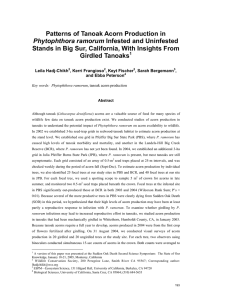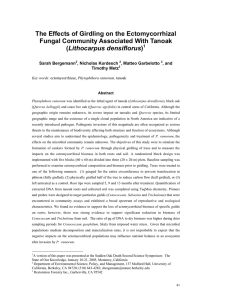Contemporary California Indian Uses for Food of Species Affected by Phytophthora ramorum
advertisement
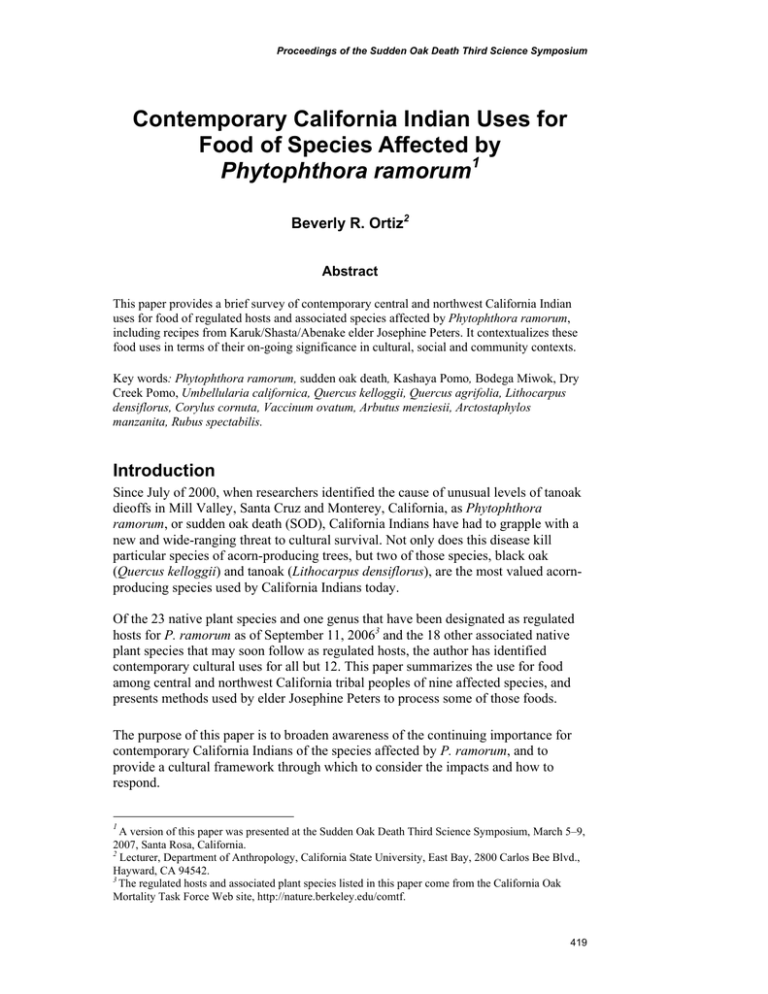
Proceedings of the Sudden Oak Death Third Science Symposium Contemporary California Indian Uses for Food of Species Affected by Phytophthora ramorum1 Beverly R. Ortiz2 Abstract This paper provides a brief survey of contemporary central and northwest California Indian uses for food of regulated hosts and associated species affected by Phytophthora ramorum, including recipes from Karuk/Shasta/Abenake elder Josephine Peters. It contextualizes these food uses in terms of their on-going significance in cultural, social and community contexts. Key words: Phytophthora ramorum, sudden oak death, Kashaya Pomo, Bodega Miwok, Dry Creek Pomo, Umbellularia californica, Quercus kelloggii, Quercus agrifolia, Lithocarpus densiflorus, Corylus cornuta, Vaccinum ovatum, Arbutus menziesii, Arctostaphylos manzanita, Rubus spectabilis. Introduction Since July of 2000, when researchers identified the cause of unusual levels of tanoak dieoffs in Mill Valley, Santa Cruz and Monterey, California, as Phytophthora ramorum, or sudden oak death (SOD), California Indians have had to grapple with a new and wide-ranging threat to cultural survival. Not only does this disease kill particular species of acorn-producing trees, but two of those species, black oak (Quercus kelloggii) and tanoak (Lithocarpus densiflorus), are the most valued acornproducing species used by California Indians today. Of the 23 native plant species and one genus that have been designated as regulated hosts for P. ramorum as of September 11, 20063 and the 18 other associated native plant species that may soon follow as regulated hosts, the author has identified contemporary cultural uses for all but 12. This paper summarizes the use for food among central and northwest California tribal peoples of nine affected species, and presents methods used by elder Josephine Peters to process some of those foods. The purpose of this paper is to broaden awareness of the continuing importance for contemporary California Indians of the species affected by P. ramorum, and to provide a cultural framework through which to consider the impacts and how to respond. 1 A version of this paper was presented at the Sudden Oak Death Third Science Symposium, March 5–9, 2007, Santa Rosa, California. 2 Lecturer, Department of Anthropology, California State University, East Bay, 2800 Carlos Bee Blvd., Hayward, CA 94542. 3 The regulated hosts and associated plant species listed in this paper come from the California Oak Mortality Task Force Web site, http://nature.berkeley.edu/comtf. 419 GENERAL TECHNICAL REPORT PSW-GTR-214 Those wishing to know more about contemporary uses by California Indians of the species affected by Phytophthora ramorum, and how California Indians are responding to its spread, are referred to another paper by the author published in the proceedings of the Sixth California Oaks Symposium: Today’s Challenges, Tomorrow’s Opportunities, October 9–12, 2006. Cultural, Social and Community Impacts of P. ramorum As Indian people we’re still using these acorns, and we’re still using the tanoak. We’ve done that since the beginning, when we first walked here, to honor our agreement that we had with those trees to provide us with our food. -Reno Franklin (Kashaya Pomo), 2007 The cultural, social and community impact of P. ramorum for tribal peoples is exemplified by presentations given by Reno Franklin and Eric Wilder of the Kashaya Band of Pomo Indians, who spoke during the Sudden Oak Death Third Science Symposium on March 5, 2007. The Kashaya people have teamed up with researcher Ted Swiecki on a grant to study whether Agrifos® can stem the spread of this disease on the tribe’s 16.19 hectare (40 acre) Stewarts Point Rancheria, and other ancestral lands, without affecting the quality and edibility of the acorns. Doctors Rizzo and Garbeletto of the University of California, Davis and Berkeley respectively, have also assisted the tribe in identifying and examining the impact of this disease. A “culturally practicing tribe” that considers tanoak acorns to be sacred, the Kashaya now refer to one area near the rancheria as “Ground Zero,” because P. ramorum has killed thousands of trees there. As explained by Reno Franklin about the cultural and social significance of tanoaks for his people, “We still continue to pass on our ceremonies, our traditions, our prayers, and our songs, and some of those songs and prayers and ceremonies are centered around tanoak and these acorns. We...still have roundhouse ceremonies that celebrate and give thanks for what we’re taking from those tanoak trees in the form of acorn. You could have a tanoak that’s maybe three or four hundred years old where five or six generations of Kashaya families go. Our elders, in this case our grandparents or our parents, our aunties and uncles, will sit down with us and tell us stories underneath these tanoaks. We’ll be gathering acorns, and they’ll teach us how to sing the songs that are appropriate for gathering, and why we’re singing those songs. We’ll learn language and stories... It’s what we call the University of Kashaya. It’s our school. [....] It’s a great way for us to connect with each other and all be a part of something. It’s a nice picnic day. P. ramorum is threatening that. We’ve got families whose entire gathering areas have been wiped out... And it’s hard to take seven generations of a family and remove something like that, and then try and fill that void.” For Kashaya people, the thought of bringing death to tanoaks by gathering plants as their ancestors have for thousands of years is not only “scary,” but a “foreign concept.” As elaborated by Eric Wilder, “This past season, this was the first time that I really saw the effect of it at our Acorn Festival. We were only able to gather enough acorns for one pot of acorn meal..., so this pathogen has devastated entire areas where our family used to pick. [....] When I was a kid, we’d have all kinds of acorns to 420 Proceedings of the Sudden Oak Death Third Science Symposium gather. We’d have eight, nine, ten pots of acorn mush out on the table, and then plenty left over that we’d store over the winter until the next season.” Held annually, the Acorn Festival provides a tangible means to give thanks to the trees for providing the acorns. Its four nights of prayer, song and dance culminate in a feast. “What happens,” asked Eric Wilder, “when you take that element from your people that is a significant ceremony, and a practice of your people that happened for thousands and thousands of years, and it’s suddenly gone? ...The acorn impact is just one element of it. It’s in our medicinal plants. It’s in our [other] foods. It’s in our technical plants. “In our traditional belief, when we go out and we gather these acorns and anything from the land, the Creator has put that here for us... This is a sacred ceremony that we do... According to the teachings of our people from thousands and thousands of years, if you don’t respect the creation, and we don’t follow those rules that we were given to gather, this is the kind of thing that will happen... In the traditional people’s view...creation’s showing us what happens when you don’t respect it..., so we feel like we’re...responsible for what’s happening, too... We’re not pointing fingers at other people and saying, ‘You brought this pathogen to us.’ ...It’s here, and it’s affecting everything that we use, and so the tribe’s position is, ‘What can we do? Can you help us? And what can we do to help you?’ [W]e all need to work together to try to find a solution to this pathogen. [....] You are part of this land with us. We are expected to follow certain rules, and so, as far as for us, we need to remember who we are and where we come from.” The Stewarts Point Rancheria encompasses an old village site called Huckleberry Heights in the Kashaya language, and the people continue to use huckleberry, now a P. ramorum host species, for food. Their word for tanoak translates “beautiful tree.” As explained by Reno Franklin, “[W]e cared a lot about this tree to give it such a pretty, descriptive name. We romanticized this tree, and we still continue to.” The Kashaya use California bay laurel, a primary host species, both for food and ceremonially. About bay laurel and tanoak, Franklin had this to say, “We’re talking about the two things that are so sacred to our tribe, and one [bay laurel] is killing the other [tanoak]... [It’s] culturally devastating to have to worry about this disease that’s coming in with our medicinal plants and kills other medicinal plants. It’s a really scary concept to an Indian person.” Community impacts include the need to cut down dead tanoaks that threaten to fall on homes, and an inability to share wood used in household wood stoves, since one household may have the disease in their backyard, but another down the street may not. As Franklin explained, “That’s a foreign concept to not share with our neighbors, especially on the reservation.” The Kashaya are but one of many California tribes who use species affected by P. ramorum in their day-to-day lives. Those individuals raised on the resultant foods commonly long for them when they are sick or dying. Earlier this year, for instance, the dying wish of one Dry Creek Pomo woman was to eat “acorn” one last time. The relative who provided that acorn, Kathleen Smith (Dry Creek Pomo and Bodega Miwok), was the second generation in recent memory to fulfill a dying wish for acorn. Her late father Steven Smith was the first (Smith 2007, personal communication). 421 GENERAL TECHNICAL REPORT PSW-GTR-214 Such foods, whose processing has been readapted to fit within the context of modern life, remain precious and enduring. A summary of the foods, and three “recipes,” are offered below in the hope that they may bring greater awareness to the ongoing use by California Indians of species affected by P. ramorum, and suggest another area of consideration when conducting research about this pathogen. The Foods Following is a summary of the use for food of both regulated hosts and associated species. California bay laurel, aka pepperwood (Umbellularia californica): In northwest California, roasted nutmeats (peppernuts) eaten for enjoyment, to prevent allergies in the spring, to prevent colds and flu in the fall, and to relieve colitis and ulcers (Ortiz and others 2006: 68-694). In central California roasted nuts pounded, formed into balls and elongate shapes, and eaten for enjoyment (Ortiz 1989: 25, Smith 2004).5 Salal (Gaultheria shallon). Berries eaten raw or canned (McCovey 20066 Ortiz and others 2006: 218). California black oak (Quercus kelloggii), Coast live oak (Quercus agrifolia), and Tanoak (Lithocarpus densiflorus). Acorns used for food throughout California.7 In northwest California, the “old timers” relished garnishing their acorn with roasted peppernut halves.8 For a Yosemite Miwok/Paiute method see Ortiz 1991. California hazelnut (Corylus cornuta). Nuts eaten raw, dried like walnuts, or baked (Colegrove 20069, McCovey 2006, Ortiz 1996/97: 27-28, 29, 30, 1998: 24-25, Ortiz and others 2006: 15-16, 30, 68, 140). Evergreen huckleberry (Vaccinum ovatum). Berries eaten raw, canned and cooked in pies and “duff” (sweetened dough balls cooked in sweetened, thickened berries, spiced with cinnamon) (Ortiz 2000:21; Ortiz and others 2006: 63, 64, 112, 148). Berries considered a staple by the Karuk and frozen for year-round use (Glaze 200310). Madrone (Arbutus menziesii). Dried berries pounded, then water added to make a sweet drink (McCovey 2006). Parry manzanita/Manzanita (Arctostaphylos manzanita). To make a sweet cider, powdered berries soaked in water, water dripped through powdered berries, or 4 Ortis, Beverly; with Bryan Colegrove; Dwayne and Patricia Ferris; Zona Ferris; Wendy Ferris George; LaVerne Glase; Holly Hensher; Jennifer Kalt; Deborah McConnell; Kathy McCovey, and Kenneth Wilson. 2006. The first full moon in April: Josephine Grant Peters (Karuk, Shasta, Abenake), her life, plant uses, and cultural knowledge; 285 p. Unpublished. 5 Field data 1983 to 1996. 6 McCovey, Kathy, Karuk cultural consultant. [Taped interview with Beverly R. Ortiz.] 13 July 2006. 7 Field data 1988 to 1992. 8 Field data 2001 to 2005. 9 Colegrove, Bryan, Hupa/Yurok/Karuk cultural consultant. [Taped interview with Beverly R. Ortiz] 13 July 2006. 10 Glaze, LaVerne, Karuk cultural consultant. [Taped interview with Beverly R. Ortiz.] 28 June 2003. 422 Proceedings of the Sudden Oak Death Third Science Symposium powdered berries wrapped in cloth and soaked in water (Ortiz 1996/97: 27, Ortiz and others 2006: 63, 167-168).11 Salmonberry (Rubus spectabilis). Berries eaten raw (Ortiz and others 2006: 219). Berries canned. Recipes The recipes that follow were compiled from field research conducted from 2001 to 2005 with Karuk/Shasta/Abenake elder Josephine Peters. Her words are quoted in italic typeface. For other recipes utilized by contemporary California Indians to process these foods, see Ortiz 1989, 1991, 1996/97, and Smith 2004. Acorn Recipe A “good crop” of “acorn” occurs every fourth year, so Josephine gathers more than a year’s supply. We always use tanoak when it’s plentiful. Dry acorns in a box near the stove for a month or so. If gathered before the rains, they’ll already be somewhat dry, and can be laid rather thickly in the box. Turn the nuts once or twice daily, whenever you think about it, so that the acorns in the middle don’t mold. Crack the nuts with a hammer, butt end up. If you crack the nuts while they’re fresh, they turn an unsightly, gray color due to bruising. When dry, the nuts virtually pop out of the shell. Use last year’s nuts with a few of the fresh to “boost up the taste.” With tanoak the skin comes right off, so there’s no need to winnow. With white oak, the skin stays on. You have to break it off. Run the nuts through a Miracle Flour Mill, using the smallest gauge, so the flour will be as fine as possible. When fine, the flour will “soak” (leach) in a couple of hours. When the flour has big chunks, it takes longer to soak. Prop a relatively finely woven twined basket atop a colander in your kitchen sink. Place a cloth atop the basket, and the acorn flour atop this, as much as an inch and a half deep depending on the amount of acorn to be leached. The cloth must be “soft,” or water won’t leach through it. Josephine uses an old flour sack. A sheet isn’t soft enough. Drip tepid water through the flour for about two hours. It removes a yellowish-colored oil, and speeds up the leaching process. If only cold water were used, leaching would take all day. In place of a water break, Josephine changes the position of her faucet from time to time, so the flour will leach evenly. As needed, after two hours, she lets cold faucet water drip through the acorn flour until not a hint of bitterness (tannin) remains. People who leave the bitterness in turn others against ever eating it. I always take all mine out. Cook in a stainless steel pot, stirring with a big, wooden spoon lest the acorn be burned on the bottom. Never use aluminum, as acorn will react with the metal. A cup of acorns will make a quart of mush. The cooked “acorn soup” should have a “pretty thick,” mush-like consistency. When people prefer it thinner, they can always add water to it. Peppernut Recipe While growing up, Josephine and her siblings ate roasted peppernuts to become immune to flu and bad colds. As a child, she learned to fix them herself. Josephine usually gathers peppernuts in the middle of October, right after hunting season, when they fall from the trees. The harvest varies from year to year and tree to tree. They 11 Field data 1980 to 2006. 423 GENERAL TECHNICAL REPORT PSW-GTR-214 always say every four years is a good nut crop. After arriving home from the harvest, Josephine squeezes the nuts out of their outer, soft hull, which she considers too bitter to eat. The skin’s oily residue helps seal the shell, so the nuts keep longer. I’ve had a lot of nuts here for three or four years. Josephine places the nuts several deep, or about one-and-a-half inches thick, in three special “boxes” she once used for sifting clay when she belonged to a Hoopa-based pottery guild. The boxes consist of a 12 × 12 frame of boards about 6 inches (15.24 cm) high with a screen that runs underneath. Josephine sun dries the nuts during the day, propping the boxes up off the ground with sticks, so there’s ample ventilation through the screen. To insure all the nuts dry well, she periodically stirs them around, and brings the boxes in at night. Once dry, after about two weeks, Josephine transfers the nuts into a cardboard box, paper bag or jar, whatever’s available for storage. Alternatively, dry the nuts in a basket one nut layer thick for three to four days before roasting. Stored in the shell, the nuts stay “soft,” or, put another way, don’t get “too old.” Josephine begins eating hers about a month after gathering them, nearer the cold and flu season. The nuts will keep for a year. Roast peppernuts in a 250 degree oven in a pie tin or cookie sheet for 45 minutes to an hour. Open the oven every five to ten minutes or so, and shake the cookie sheet, so the nuts roll. It takes the bitterness out if you cook it slow. We keep shaking them up so they roast evenly. Without shaking, the nuts may burn on one side. Josephine determines when the nuts have been properly roasted by the color of the shell, which turns from a yellowish tan to a light brownish-black to a dark brown. Although hot when removed, the nuts cool fairly quickly. If cooked too long, they’ll burn, ruining their flavor. Cooked properly they retain a slight hint of their original bitterness, nothing that detracts from the taste. Josephine cracks the thin shells with her teeth. The nut separates into two halves. A papery skin between the halves comes right off. Peppernuts taste similar to a coffee bean. Josephine eats hers plain, or adds them into acorn soup. Eat the roasted nuts within a season. They absorb moisture through the shell, and eventually become soft and chewy, which damages the taste. Josephine stores roasted ones in a jar. Manzanita Berry Cider Recipe Gather manzanita berries off fire roads, where they’re clean. We go up in the mountains and pick, if we can beat the bears to them. [laughs] Pick large clumps of berries by the handful. Remove the stems by rolling the berries in a circular, openwork basket woven close enough to contain the fruit, but open enough for the stems to fall through. Josephine’s mother made a sweet drink from manzanita berries by pounding the red, ripened berries in a wooden bowl until the skin powdered. Of course they’ve got a lot of seed in them, and not much powder. She’d pound it all up, and put it in a gallon jar. She used to call it cider. It made a nice drink… We’d drink it like we do Kool Aid. The sweetness leached from the powder as it sat in cold water in the jar. Once the water was sweet, she strained out the powder through a flour sack. Josephine powders her berries by putting them through the biggest chopper in an old meat grinder. She sifts out the hard seeds, some of which get broken up, with a screen sifter or handled sieve. She soaks the powder in a big jar, stirring it up before drinking. 424 Proceedings of the Sudden Oak Death Third Science Symposium Conclusion The spread of P. ramorum into several coastal and near-coastal, California counties, threatens a vital, thousands-of-years-old relationship between people, cultural heritage, plants and their homelands. Cultural, social, community, emotional, spiritual and historical ties connect people to their homelands, and traditionalist California Indians feel an obligation to Creation, and the Creator, to continue to use plants within these homelands for food and other cultural purposes, while care taking the plants in culturally proscribed ways. This brief survey of the on-going significance of host and associated species affected by P. ramorum for food by California Indians is intended to call attention to some of the lesser-known impacts of this pathogen. As California Indians grapple with the cultural and ecological implications of P. ramorum, they face new challenges in the continuance of their cultures. They are currently reaching out to researchers to help them examine and respond to these challenges. Literature Cited Ortiz, Beverly 1989. Things have changed [Auberry Mono acorn making]. News from Native California. 2(6): 22–24. Ortiz, Beverly. 1991. It will live forever: Traditional Yosemite Indian acorn making. 2nd edition. Berkeley. Heyday Books: 148 p. Ortiz, Beverly. 1996/97. Regathering a tradition. News from Native California 10(2): 27–30. Ortiz, Beverly. 2000. Simply healthy: food and fitness in native California [Pomo and Coast Miwok foods]. News from Native California 13(3): 21–22. Smith, Kathleen. 2004. You’ll never go hungry. In: Jacknis, Ira (editor). Food in California Indian culture; classics in California anthropology series. Berkeley: Hearst Museum of Anthropology: 415–420. 425

